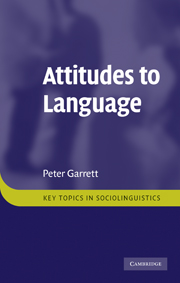Book contents
- Frontmatter
- Contents
- List of figures
- List of tables
- Acknowledgements
- 1 Introduction
- 2 Fundamentals of language attitudes
- 3 Main approaches to the study of language attitudes
- 4 Matched and verbal guise studies: focus on English
- 5 Matched and verbal guise research in more contexts
- 6 Attitudes to speech styles and other variables: communication features, speakers, hearers and contexts
- 7 Communication accommodation theory
- 8 Language attitudes in professional contexts
- 9 Societal treatment studies
- 10 Direct approach
- 11 Folklinguistics
- 12 An integrated programme of language attitudes research
- 13 Conclusion
- Glossary
- References
- Index
- References
3 - Main approaches to the study of language attitudes
Published online by Cambridge University Press: 05 June 2012
- Frontmatter
- Contents
- List of figures
- List of tables
- Acknowledgements
- 1 Introduction
- 2 Fundamentals of language attitudes
- 3 Main approaches to the study of language attitudes
- 4 Matched and verbal guise studies: focus on English
- 5 Matched and verbal guise research in more contexts
- 6 Attitudes to speech styles and other variables: communication features, speakers, hearers and contexts
- 7 Communication accommodation theory
- 8 Language attitudes in professional contexts
- 9 Societal treatment studies
- 10 Direct approach
- 11 Folklinguistics
- 12 An integrated programme of language attitudes research
- 13 Conclusion
- Glossary
- References
- Index
- References
Summary
Many authors identify three broad approaches to studying people's attitudes towards language (e.g. Ryan, Giles and Hewstone 1988), and so these are used as a framework for grouping studies in this book. These approaches are called the analysis of the societal treatment of language varieties (also referred to as ‘content analysis’ by Knops and van Hout 1988: 6), direct measures and indirect measures (indirect measures are sometimes referred to as the ‘speaker evaluation paradigm’, or ‘the matched guise technique’ in the language attitudes literature). As with any research methods, the methods within each of these approaches have their own strengths and weaknesses. In this chapter, these three approaches are exemplified, outlined and considered.
As mentioned at the end of chapter 1, there is stronger reference in these early chapters to some of the early work in language attitudes, showing how the field was ‘laid down’. A greater proportion of more contemporary research comes to fore as the book moves forward.
DIRECT APPROACH
MacKinnon's study of attitudes to Scottish Gaelic
MacKinnon (1981) reported a large-scale survey of attitudes to Gaelic in Scotland. In total, attitude data was collected from a sample of 1,117 respondents, aged fifteen and over, living in the Scottish Lowland and Highland regions, Skye and the Western Isles. The survey employed a questionnaire which contained sixteen questions, and respondents chose one of six possible responses: ‘strongly disagree’, ‘disagree on the whole’, ‘no feelings either way’, ‘agree on the whole’, ‘strongly agree’ and ‘no response’.
- Type
- Chapter
- Information
- Attitudes to Language , pp. 37 - 52Publisher: Cambridge University PressPrint publication year: 2010
References
- 1
- Cited by

